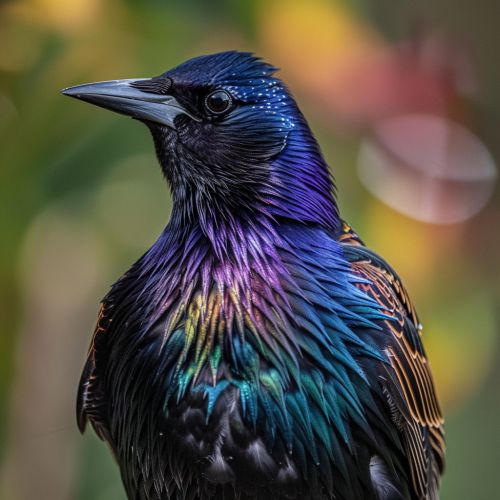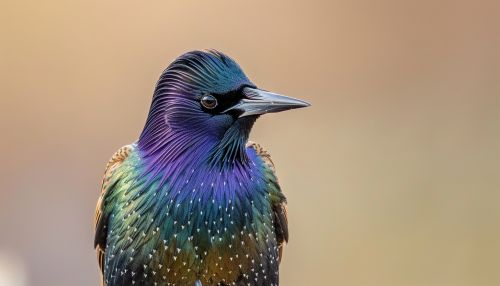Starling
Introduction
The Starling is a small to medium-sized passerine bird belonging to the family Sturnidae. Known for their iridescent plumage and complex vocalizations, starlings are native to the Old World, including Europe, Asia, and Africa. However, they have been introduced to other parts of the world, including North America and Australia, where they have become invasive species. This article delves into the biology, behavior, ecology, and impact of starlings, providing a comprehensive understanding of these fascinating birds.
Taxonomy and Evolution
Starlings belong to the order Passeriformes, which is the largest order of birds, encompassing over half of all bird species. The family Sturnidae includes around 120 species, divided into several genera. The most well-known species is the European Starling (Sturnus vulgaris), which has been extensively studied due to its widespread distribution and impact on ecosystems.
Phylogeny
The phylogenetic relationships within the Sturnidae family have been the subject of extensive research. Molecular studies using mitochondrial DNA have revealed that starlings are closely related to the Mimidae family, which includes mockingbirds and thrashers. This relationship is supported by similarities in their vocalization patterns and ecological niches.
Fossil Record
The fossil record of starlings is relatively sparse, but several important finds have shed light on their evolutionary history. The oldest known starling fossils date back to the Miocene epoch, approximately 20 million years ago. These fossils, found in Europe and Asia, suggest that starlings originated in the Old World and later dispersed to other regions.
Morphology
Starlings exhibit a range of morphological features that distinguish them from other passerine birds. They typically have strong, straight bills adapted for probing and foraging. Their plumage is often iridescent, displaying a range of colors depending on the angle of light. This iridescence is due to the microscopic structure of their feathers, which refract light in different ways.
Plumage and Coloration
The iridescent plumage of starlings is one of their most striking features. This coloration is not due to pigments but rather to the microscopic structure of the feathers, which causes light to be refracted and reflected in various colors. This structural coloration can serve multiple functions, including sexual selection and camouflage.


Size and Shape
Starlings vary in size, with the smallest species, such as the Dwarf Starling (Aplonis minor), measuring around 15 cm in length, and the largest species, such as the Nias Hill Myna (Gracula robusta), reaching up to 30 cm. They have a robust body, short tail, and strong legs, which are well-adapted for their terrestrial lifestyle.
Behavior
Starlings are known for their complex social behaviors and vocalizations. They are highly gregarious, often forming large flocks, especially during the non-breeding season. Their social structure is hierarchical, with dominant individuals having priority access to resources.
Vocalizations
Starlings are exceptional mimics, capable of imitating a wide range of sounds, including the calls of other birds, human speech, and mechanical noises. This ability is thought to play a role in social interactions and mate attraction. The European Starling is particularly renowned for its complex and varied song, which can include up to 35 different song types.
Foraging and Diet
Starlings are omnivorous, feeding on a diverse diet that includes insects, fruits, seeds, and even small vertebrates. They are opportunistic feeders, often exploiting human-altered environments such as agricultural fields and urban areas. Their foraging behavior is highly adaptable, allowing them to thrive in a wide range of habitats.
Reproduction
The breeding behavior of starlings is characterized by elaborate courtship displays and nest-building activities. They are generally monogamous, although instances of polygyny and extra-pair copulations have been documented.
Nesting
Starlings typically nest in cavities, including tree holes, rock crevices, and artificial structures such as buildings and nest boxes. They are known to be aggressive competitors for nesting sites, often displacing other cavity-nesting species. The nest is constructed from a variety of materials, including grass, leaves, and feathers.
Breeding Cycle
The breeding season for starlings varies depending on the species and geographic location. In temperate regions, it usually occurs in the spring and early summer. The female lays a clutch of 4-6 eggs, which are incubated for about 12-15 days. Both parents participate in feeding the chicks, which fledge after approximately three weeks.
Ecology
Starlings occupy a wide range of habitats, from forests and grasslands to urban areas and agricultural landscapes. Their ecological impact is significant, both in their native and introduced ranges.
Habitat
Starlings are highly adaptable and can thrive in a variety of environments. In their native range, they are commonly found in open woodlands, savannas, and grasslands. In urban areas, they exploit a range of habitats, including parks, gardens, and buildings.
Invasive Species
The introduction of starlings to new regions has often resulted in negative ecological impacts. In North America, the European Starling is considered an invasive species, competing with native birds for food and nesting sites. Their aggressive behavior and high reproductive rate have allowed them to establish large populations, leading to significant ecological and economic consequences.
Conservation
The conservation status of starlings varies widely among species. While some species are abundant and widespread, others are threatened by habitat loss, hunting, and other human activities.
Threatened Species
Several starling species are listed as threatened or endangered by the International Union for Conservation of Nature (IUCN). For example, the Bali Myna (Leucopsar rothschildi) is critically endangered due to habitat destruction and illegal trapping for the pet trade. Conservation efforts for these species include habitat protection, captive breeding programs, and reintroduction initiatives.
Conservation Efforts
Conservation efforts for starlings focus on habitat preservation, legal protection, and public awareness campaigns. In some regions, efforts are also made to control invasive starling populations to mitigate their impact on native ecosystems. These efforts often involve a combination of strategies, including habitat management, population monitoring, and research on starling ecology and behavior.
